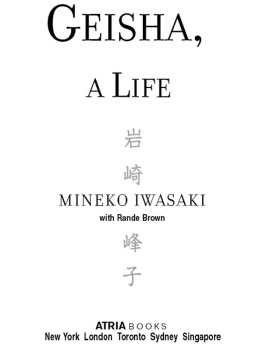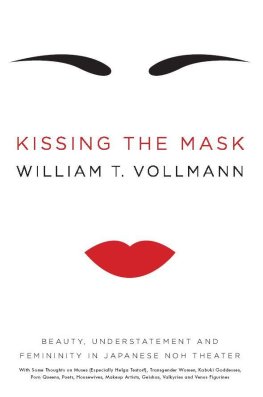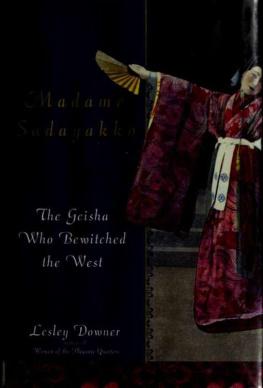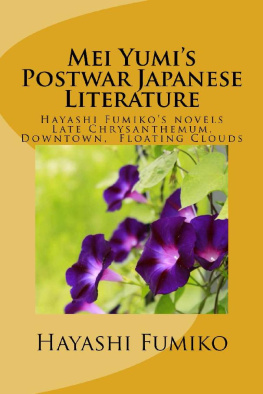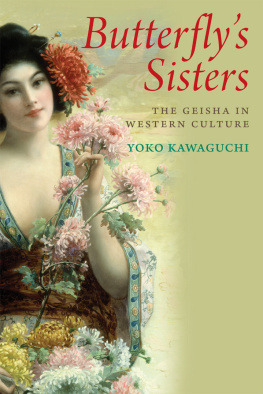All rights reserved including the right to reproduce this book or portions thereof in any form whatsoever. For information address Atria Books, 1230 Avenue of the Americas, NY 10020
ATRIA BOOKS is a registered trademark of Simon & Schuster, Inc.
Photos courtesy of the author.
I N THE COUNTRY OF JAPAN , an island nation in East Asia, there are special districts, known as karyukai, that are dedicated to the enjoyment of aesthetic pleasure. These are the communities where the professionally trained female artists known as geisha live and work.
Karyukai means the flower and willow world. Each geisha is like a flower, beautiful in her own way, and like a willow tree, gracious, flexible, and strong.
No woman in the three hundredyear history of the karyukai has ever come forward in public to tell her story. We have been constrained by unwritten rules not to do so, by the robes of tradition, and by the sanctity of our exclusive calling.
But I feel it is time to speak out. I want you to know what it is really like to live the life of a geisha, a life filled with extraordinary professional demands and richly glorious rewards. Many say I was the best geisha of my generation; I was certainly the most successful. And yet, it was a life that I found too constricting to continue. And one that I ultimately had to leave.
It is a story that I have long wanted to tell.
My name is Mineko.
This is not the name my father gave me when I was born. It is my professional name. I got it when I was five years old. It was given to me by the head of the family of women who raised me in the geisha tradition. The surname of the family is Iwasaki. I was legally adopted as the heir to the name and successor to ownership of the business and its holdings when I was ten years old.
I started my career very early. Events that happened when I was only three years old convinced me that it was what I was meant to do.
I moved into the Iwasaki geisha house when I was five and began my artistic training when I was six. I adored the dance. It became my passion and object of greatest devotion. I was determined to become the best and I did.
The dance is what kept me going when the other requirements of the profession felt too heavy to bear. Literally. I weigh 90 pounds. A full kimono with hair ornaments can easily weigh 40 pounds. It was a lot to carry. I would have been happy just to dance, but the exigencies of the system forced me to debut as an adolescent geisha, a maiko, when I was fifteen.
The Iwasaki geisha house was located in the Gion Kobu district of Kyoto, the most famous and traditional karyukai of them all. This is the community in which I spent the entirety of my professional career.
In Gion Kobu we dont refer to ourselves as geisha (meaning artist) but use the more specific term geiko, woman of art. One type of geiko, famed throughout the world as the symbol of Kyoto, is the young dancer known as a maiko, or woman of dance. Accordingly, I will use the terms geiko and maiko throughout the rest of this book.
When I was twenty I turned my collar, the rite of passage that signals the transformation from maiko to adult geiko. As I matured in the profession, I became increasingly disillusioned with the intransigence of the archaic system and tried to initiate reforms that would increase the educational opportunities, financial independence, and professional rights of the women who worked there. I was so discouraged by my inability to effect change that I finally decided to abdicate my position and retire, which, to the horror of the establishment, I did at the height of my success, when I was twenty-nine years old. I closed down the Iwasaki geisha house, then under my control, packed up the priceless kimono and jeweled ornaments contained within, and left Gion Kobu. I married and am now raising a family.
I lived in the karyukai during the 1960s and 1970s, a time when Japan was undergoing the radical transformation from a post-feudal to a modern society. But I existed in a world apart, a special realm whose mission and identity depended on preserving the time-honored traditions of the past. And I was a fully committed to doing so.
Maiko and geiko start off their careers living and training in an establishment called an okiya (lodging house), usually translated as geisha house. They follow an extremely rigorous regimen of constant classes and rehearsal, similar in intensity to that of a prima ballerina, concert pianist, or opera singer in the West. The proprietress of the okiya supports the geiko fully in her efforts to become a professional and then helps manage her career once she makes her debut. The young geiko lives in the okiya for a contracted period of time, usually five to seven years, during which time she repays the okiya for its investment. She then becomes independent and moves out on her own, though she continues to maintain an agency relationship with her sponsoring okiya.
The exception to this is a geiko who has been designated as an atotori, an heir to the house, its successor. She carries the last name of the okiya, either through birth or adoption, and lives in the okiya throughout her career.
Maiko and geiko perform at very exclusive banquet facilities known as ochaya, often translated literally as teahouses. Here we entertain regularly at private parties for select groups of invited patrons. We also appear publicly in a series of annual performance events. The most famous of these is the Miyako Odori (Cherry Dances). The dance programs are quite spectacular and draw enthusiastic audiences from all over the world. The Miyako Odori takes place for the month of April in our own theater, the Kaburenjo.
There is much mystery and misunderstanding about what it means to be a geisha or, in my case, a geiko. I hope my story will help explain what it is really like and also serve as a record of this unique component of Japans cultural history.
Please, journey with me now into the extraordinary world of Gion Kobu.
1
I FIND GREAT IRONY in my choice of profession.
A first-class geiko is constantly in the glare of spotlights while I spent much of my childhood hiding in a darkened closet. A first-class geiko uses all the skills at her command to please her audience, to make every person she comes in contact with feel wonderful, while I prefer solitary pursuits. A first-class geiko is an exquisite willow tree who bends to the service of others while I have always been stubborn and contrary by nature, and very, very proud.
While a first-class geiko is a master of creating an atmosphere of relaxation and amusement, I dont particularly enjoy being with other people.
A star geiko is never, ever alone and I always wanted to be by myself.
Odd, isnt it? Its almost as if I was deliberately choosing the most difficult path for myself, one that would force me to face and overcome my personal obstacles.
In fact, if I hadnt entered the karyukai, I think I would have become a Buddhist nun. Or a policewoman.
It is difficult to explain why I made the decision to enter the karyukai when I was such a little girl.
Why would a small child who adores her parents decide by herself to leave them? Yet I was the one who chose to enter this profession and this workplace, thus betraying my parents.

